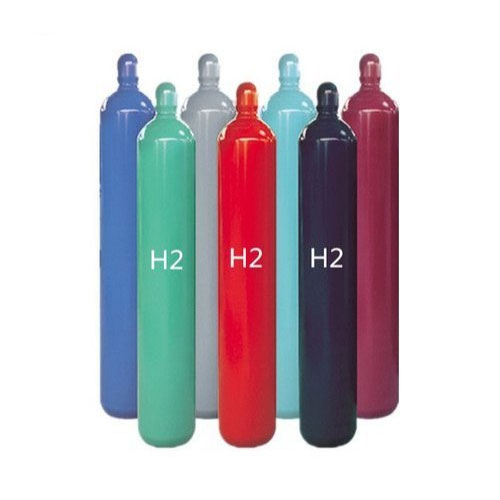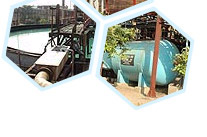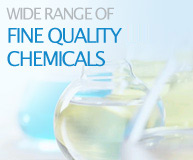Hydrogen Gas
 |
|
|
Hydrogen is produced by the steam reforming of natural gas, the electrolysis of water, the dissociation of ammonia, and as a by-product of petroleum distillation and chlorine manufacture, with the primary method for on-purpose generation being the steam reforming of natural gas. Other feedstocks can include ethane, propane, butane, and light and heavy naphtha but are not commonly used. The steam reforming process produces syngas, which is a mixture of hydrogen and carbon monoxide. Regardless of the method of production, the product steam is then separated into its components and the hydrogen dried, purified, and compressed into cylinders or tubes for transportation.
Applications
- Hydrogen is used in the chemical industry to synthesize ammonia and in the hydrogenation of vegetable and animal oils and fats.
- In the metallurgical industry, hydrogen is used to reduce metal oxides and prevent oxidation in heat-treating certain metals and alloys. Some use of hydrogen is made in the welding and cutting of metals. Hydrogen is also used by semiconductor manufactures, primarily to form reducing atmosphere.
Sources
- Natural gas (Methane) is the primary source for producing hydrogen
by SMR (Steam Methane Reformation)
- There are other renewable methods through live stock waste, land
fill biomas, waste water sludge, chemical reactions and electricity from
solar, wind and water power, fossil fuel.
- It can also be prepared from water through Electrolysis process
Safety
Although any fuel we use is inflammable & dangerous
but hydrogen is non toxic, light so it scatters immediately upward when
there is a leak, rather than pooling about polluting ground water soaking in
to clothes. So if handled with care, it is safer than fuels in standard use.
Negative aspects
Storage : Since Hydrogen is light, it
is difficult to store a lot of it in a small tank.
Distribution : There is not a wide spread distribution
channel like other channels for other fuels. New infra structure is needed
to put in place.
Cost :Hydrogen is much more expensive than gasoline since
other resources are reaching there peak, the gases will come at par.
Danger : It is flammable & even explosives under
certain conditions.
Safety
Gaseous Hydrogen
General
Hydrogen is a colorless, odorless, tasteless, highly flammable gas. It is
also the lightest-weight gas. Since hydrogen is noncorrosive, special
materials of construction are not usually required. However, embrittlement
occurs in some metals at elevated temperatures and pressures. Stationary
vessels and piping should be designed to the American Society of Mechanical
Engineers (ASME) code and the American National Standards Institute (ANSI)
Pressure Piping code for the pressures and temperature involved. Vessels
used for transportation must be designed to meet the Department of
Transportation (DOT) code.
Gaseous hydrogen may be supplied in tube trailers and cylinders. Hydrogen
is usually compressed into gas cylinders by oil-lubricated compressors. The
amount of gas in a cylinder is determined by the pressure, temperature,
cylinder size, and cylinder pressure rating.
The molecular symbol for hydrogen is H2.
Health
Hydrogen gas is odorless and nontoxic but may induce
suffocation by diluting the concentration of oxygen in air below levels
necessary to support life.
Caution :
The amount of hydrogen gas necessary to produce
oxygen-deficient atmospheres is well within the flammable range, making fire
and explosion the primary hazards associated with hydrogen and air
atmospheres.
Flammability
The wide flammability range, 4% to 74% in air, and the
small amount of energy required for ignition necessitate special handling to
prevent the inadvertent mixing of hydrogen with air. Care should be taken to
eliminate sources of ignition such as sparks from electrical equipment,
static electricity sparks, open flames, or any extremely hot objects
Hydrogen and air mixtures, within the flammable range, can explode and may
burn with a pale blue, almost invisible flame.
Properties
| Molecular Weight |
2.016 |
| Boiling Point @ 1
atm |
-423.2°F
(-252.9°C) |
| Freezing Point @ 1
atm |
-434.8°F
(-259.3°C) |
| Critical
Temperature |
-400.4°F
(-240.2°C) |
| Critical Pressure
|
186 psia (12.7
atm) |
| Density, Liquid @
B.P., 1 atm |
4.42 lb./cu.ft. |
| Density, Gas @ 68°F
(20°C), 1 atm |
0.005229
lb./cu.ft. |
| Specific Gravity,
Gas (Air=1) @ 68°F (20°C), 1 atm |
0.0696 |
| Specific Gravity,
Liquid @ B.P., [water=1 @ 68°F (20°C)] |
0.0710 |
| Specific Volume @
68°F (20°C), 1 atm |
191 cu. ft./lb.
|
| Latent Heat of
Vaporization |
389 Btu/lb. mole
|
| Flammable Limits @
1 atm in air |
4.00% - 74.2% (by
Volume) |
| Flammable Limits @
1 atm in oxygen |
3.90% - 95.8% (by
Volume) |
| Detonable Limits @
1 atm in air |
18.2% - 58.9% (by
Volume) |
| Detonable Limits @
1 atm in oxygen |
15% - 90% (by
Volume) |
| Autoignition
Temperature @ 1 atm |
1060°F (571°C) |
| Expansion Ratio,
Liquid to Gas, B.P. To 68°F (20°C) |
1 to 845 |
Specifications
Cylinders and mobile tubes are manufactured according to
DOT-3A or DOT-3AA specifications. Cylinders and mobile tubes are
hydrostatically tested upon manufacture and tested periodically thereafter
at 5/3 times the service pressure, as specified by DOT regulations.
Hydrogen may be stored in ASME coded and stamped, National Board registered
high-pressure gas storage tubes are part of a stationary installation. These
tubes are hydrostatically tested by the manufacturer but, unlike cylinders
and mobile tubes, periodical hydrostatic testing is not required.
The Compressed Gas Association and the American National Standards
Institute have recommended a thread size of 0.825 inch-14 external left-hand
threads per inch, designated as valve connection No. 350. Further
information on valves is provided in Air Products' Safetygram-23, "Cylinder
Valves", and Safetygram-31, "Cylinder Valve Outlet Connections."
Pressure Relief Devices
Pressure relief devices provide protection against
excessive pressure in the container. Pressure relief devices are integral
parts of the cylinder valves. They are also recommended for use on
pressurized systems. These devices take the form of frangible disks or
pressure relief valves. Further information on pressure relief devices is
provided in Safetygram-15.
Identification : Cylinders and Mobile Tubes
Each cylinder or mobile tube is identified by stampings
in the metal of the cylinder shoulder. Figure 3 depicts an example of these
markings and what they mean.
Shipment : Hydrogen Cylinders
The shipment of hydrogen cylinders by surface
transportation must conform to DOT regulations as set forth in the Code of
Federal Regulations, Title 49, which describes the marking, labeling,
placarding, and shipping papers required. A DOT 4'' x 4'' red, flammable
label, as illustrated in Figure 4, is required for common carrier shipments.
For emergency response, refer to UN Number 1049 in the Department of
Transportation's "Emergency Response Guide." Shipments by air must
conform with Title 49 in the Code of Federal Regulations. Final acceptance
for air transport is at the discretion of the airline.
Key to Cylinder Stampings
Cylinder Specification
· DOT - Department of Transportation, which is the regulatory body
that governs the use of cylinders.
· Specification of the cylinder type of material of construction
(e.g., 3AA).
· Service or working pressure in pounds per square inch (e.g., 2,265
psi).
Cylinder Serial Number
· The letters SG precede the serial numbers for Specialty Gas
cylinders
Registered Owner Symbol
· Symbol used to indicate the original owner of the cylinders.
· APROINC is a Registered Owner Symbol for Air Products.
Date of Manufacture
· This date (month-year) also indicates the original hydrostatic test.
Neck Ring Identification
· The cylinder neck ring displays the name of the current owner of the
cylinder
Retest Markings
· The format for a retest marking is : Month-Facility-Year-Plus
Rating-Star Stamp.
· The symbol (Plus Rating) indicates that the cylinder qualities for
10% overfill.
· The * symbol (Star Stamp) indicates that the cylinder meets the
requirements for 10-year retest.
CylinderTrak™ Bar Code Label
· The CylinderTrak bar code label provides a unique cylinder
identifier and is used by computer systems to track cylinders throughout the
fill process. As an optional service, we have the capability of tracking
cylinders to and from customers.
Cylinder Manufacturer's Inspection Marking
Cylinder Tare (Empty) Weight
Handling and Storage of Cylinders
1. Never drop cylinders or permit them to strike each other violently.
2. Cylinders should be assigned a definite area of storage. The area should
be dry, cool, well-ventilated, and preferably fire-resistant. Keep cylinders
protected from excessive temperature by storing them away from radiators or
other sources of heat.
3. Cylinders may be stored in the open, but in such cases should be
protected against extremes of weather and from damp ground to prevent
rusting.
4. The valve protection cap should be left in place until the cylinder has
been secured against a wall, a bench, or placed in a cylinder stand and is
ready to be used.
5. Avoid dragging or sliding cylinders, even for short distances. Cylinders
should be moved by using a suitable hand truck.
6. Do not use cylinders as rollers for moving material or other equipment.
7. Never tamper with safety devices in valves or cylinders.
8. When returning empty cylinders, close the valve before shipment. Leave
some positive pressure in the cylinder. Replace any valve outlet and
protective caps originally shipped with the cylinder. Mark and label the
cylinder as "Empty". Do not store full and empty cylinders
together.
9. No part of a cylinder should be subjected to a temperature above 125°F
(52°C). Prevent sparks or flames from welding or cutting torches or any
other source coming in contact with cylinders. Do not permit cylinders to
come in contact with electrical apparatus or circuits.
10. Never permit oil, grease, or other readily combustible substances to
come in contact with cylinders or valves.
11. Use regulators and pressure relief devices when connecting cylinders to
circuits having lower pressure service ratings.
12. Smoking or open flames should be prohibited in hydrogen cylinder and
tube storage and use areas.
13. Know and understand the properties, uses, and safety precautions of
hydrogen before using the gas and associated equipment. Consult the Air
Products Material Safety Data Sheet (MSDS) for safety information.
14. Always open a cylinder valve slowly. Never crack open a hydrogen
cylinder to clear the valve of dust, as the escaping hydrogen may ignite.
15. Total storage capacity of an indoor hydrogen system should be limited
to 3000 cubic feet or less.
16. Hydrogen storage inside a building should not be near oxidants or other
combustible storage.
17. When finished with a cylinder, always close the valve. When work is to
be interrupted for any length of time, the valve should be closed and all
gas released from the hose and regulator to a safe location.
18. If a cylinder or valve is defective or leaking, remove the cylinder to
a remote outdoor location away from possible sources of ignition, and post
the area as to the hazard involved. Notify your supplier.
19. If a cylinder protective cap is extremely difficult to remove, do not
apply excessive force or pry the cap loose with a bar inserted into the
ventilation openings. Attach a label or tag to the cylinder identifying the
problem and return the cylinder to the supplier.
20. Wrenches should not be used on valves equipped with a handwheel. If the
valve is faulty, attach a label or tag to the cylinder identifying the
problem and return the cylinder to the supplier.
21. Compressed gas cylinders should not be refilled except by qualified
producers of compressed gases.
22. Shipment of a compressed gas cylinder filled without the consent of the
owner is a violation of Federal Law.









